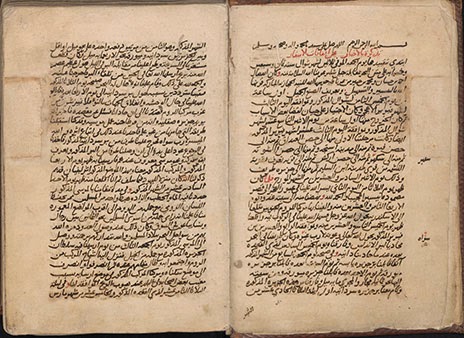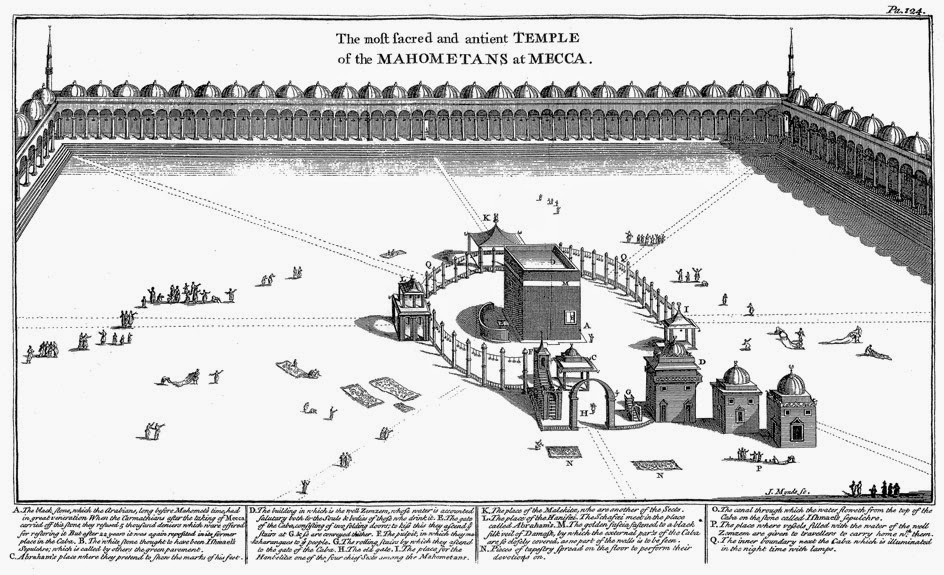The Islamic pilgrimage, called "Hajj", represents the fifth pillar of the five basic acts in Islam which are considered mandatory for every Muslim, the Five Pillars of Islam. These pillars are Shahada (Declaration of Faith), Salat (ritual prayer, performed five times a day), Zakat (giving 2,5% of one's savings to the poor and needy), Saum (fasting and self-control during the Islamic month of Ramadan) and Hajj (the pilgrimage to Makkah once in a lifetime if one is able to).
The Hajj contains many rituals, which are performed by the pilgrim. The main rituals include walking seven times around the Kaaba (the black cube inside the Mosque Al-Haram in Makkah, considered the holiest place of the Islamic world) termed Tawaf, touching the Black Stone termed Istilam, traveling seven times between Mount Safa and Mount Marwah termed Sa'yee, and symbolically stoning the Devil in Mina termed Ramee. Additionally to those rituals there exist many different obligatory deeds and recommended acts of worship such as the rituals connected to approaching or entering Makkah as well as completing the pilgrimage and returning home. As an example the way the clothing Ihram, consisting of two plain white sheets worn by male pilgrims, is folded.
The pilgrimage is considered a life-changing event in every Muslims life but its realization is not seen as self-evident. Globally speaking it is still the wealthy and fortunate who attend the journey,
although nowadays more affordable plane tickets have replaced exclusive traveling, such as ship- and caravan-transportation. Both the spiritual meaningfulness and the actualization of the unlikely are reasons for the popularity of certificates attesting a person’s pilgrimage and other documentation of the journey. As a third aspect comes the possible improvement of one's socio economic status after a completed pilgrimage, which creates a need for attestation.
“Please forgive me if I have done you wrong. I am going on Hajj.” (2012) Newsha Tavakolian
The rituals of the Hajj have not changed much since their introduction through the Quran and the Sunnah (teachings and practices of the Islamic prophet Muhammad). But very much alike today's Muslims, the Muslims of earlier generations needed advice and guidance in order to perform the complicated rituals of the Hajj in correct manner and order.
Reports and guides on the pilgrimage
Written and illustrated guides on Hajj existed throughout the Islamic world already around 1000, produced by pilgrims and outsiders who had travelled from distant countries and continents to perform or witness the pilgrimage. More remarkable guides and detailed accounts of experience are though dated back to 1200 from where we witness a steady grow of this kind of scriptures.
"The travels of Ibn Jubair", written by Ibn Jubair (d.1217), is a detailed first-hand account on the journey from Andalucía (Spain) to Makkah. Jubair began his journey on 3rd February 1183 and after travelling up the Nile and passing through the desert of 'Aidhab he arrived in Makkah on the 4th of August, having travelled for six months. Later his report was extensively read by other important travelers who performed the pilgrimage.
"As we marched that night, the full moon had thrown its rays upon the earth, the night had lifted its veil, voices struck the ears with cries of “Here I am O God, here I am” from all sides."
R.J.C. Broadhurst (transl.) “The travels of Ibn Jubayr” (London 1952, reprint 2004) p. 75
The Travels (Rihla) of Ibn Jubayr (875/1470, Mecca). Leiden University Library (OR.320, fols. 2-3)
Alongside with the spread of Islam from the Arabian Peninsula into Africa, Persia, Asia, Spain, the Balkans and the Indian subcontinent under the Seljuk and later the Ottomans, the European interest in Islam began to grow. Parallelly Islam was seen as a threat to Christian Europe, especially since the Ottoman Empire defended its frontiers against European powers successfully, it was basically exterminated from Europe in the 1490s through the Reconquista ("reconquest", a period of militant Christianizing on the Iberian Peninsula that lasted 800 years).
Considering these problematic times it comes as a surprise when an Italian traveler and aristocrat, Ludovico di Varthema (ca. 1470-1517) undertakes the difficulties of a distant journey and travels to Makkah in 1503. He travels to Cairo and from where he continues over Syria to the Arabian Peninsula, taking the Arabic name Yunas (Jonas) as a pseudonym, in order to hide his European origin. Pretending to be a Muslim was considered a serious crime both in Muslim Syria as well as in Italy, but Varthema realizes this to be the only way to enter the holy cities, Makkah and Medina. Everything he experiences there he captures in his writings and drawings, that he later on pulls together into a book, entitled Itinerario de Ludouico de Varthema ("Route of Ludovico di Varthema").
Varthemas writings are followed by a large number of others, such as the beautifully illustrated ten volume work called the Seyahatname (the Book of Travels) by Evliya Çelebi (performed Hajj in 1672) and The Joy of Stopping-Places by Mehmed Edib, an Ottoman judge from Crete (Performed Hajj in 1790).
A True and Faithful Account of the Religion and Manners of the Mahometans by Joseph Pitts (1663 –1735), Royal Geographic Society, 330090
Joseph Pitts (1663 - 1735) A True and Faithful Account of the Religion and Manners of the Mahometans is exceptional in the way that the author was both European and Muslim and prescribes the Hajj that he performed in 1680, in the age of 17.
"The Beat-Allah (Bayt Allah, the House of God or the Kaaba) which stands in the middle of the Temple, is Four-square, about twenty four Paces each Square, and nearly four Foot in Height. 'Tis build with great Stone, all smooth and plain, without the least bit of carv’d Work on it. ‘Tis covered all over from top to bottom, with a sort of Silk....The top of the Beat is flat, beaten with Lime and Sand; and there is a long Gutter or Spout, so carry off the Water when it rains; at which time the people will run, throng, and struggle, to get under the said Gutter, that so the Water that comes off the Beat may fall upon them, accounting it as the Dew of Heaven, and looking on it as of great Happiness to have it drop upon them."
"It was a sight indeed, able to pierce one’s heart, to behold so many thousands of Muslims in their garments of humility and mortification, with their naked heads, and cheeks watered with tears." (About Mount Arafat)
P.Auchterlonie 2012. Encountering Islam. Joseph Pitts: an English Slave in 17th-century Algiers and Mecca. London 2012, pp. 190-191
Anis al-Hujjaj
One of the most stunning documents on the pilgrimage is the Anis al-Hujjaj, the Pilgrim's Companion, by Safi ibn Vali, an Indian scholar, whose pilgrimage (1676) was sponsored by Zib al-Nisa, the daughter of Aurangzeb, the sixth emperor of the Mughal Empire and ruler over most of the Indian subcontinent. Aurangzeb is known as a strong and effective ruler such as an notable expansionist. As a political and religious conservative he abandoned the secularist and liberal viewpoints of his predecessors and gave way to religious intolerance. The Establishment of Islamic Law, the Sharia, is concerned to be one of his most notable achievements.
Matt Biggs for the British Museum
Every year two of his royal ships traveled to the Red Sea carrying hundreds of pilgrims. It was not easy to pass the Portuguese, who had recently begun encroaching on the Indian Ocean and attacking Muslim shipping, so that the religious scholars of the Mogul court declared the Hajj as nonbinding under these circumstances.
Safi ibn Vali reached Makkah in 1676 and undertook a year-long pilgrimage, during which he wrote and illustrated the Anis al-Hujjaj. It gives advice to prospective pilgrims on every aspect of the journey, starting from which ships to choose and how to stay healthy. He had a wide knowledge of the teachings of Islam and was trusted as a scholar (he had been asked to write a commentary on the Quran for Zib al-Nisa) and this is seen in his illustrations which often give advice in affairs of worship and behavior during the pilgrimage.
From the “Anis al-Hujjaj”, Nasser D. Khalili Collection of Islamic Art, MSS 1025 fols 2b, 3b, 21a, 22b (© Nour Foundation. Courtesy of the Khalili Family Trust)
“The illustrations start on the left with the port of Surat north of Bombay which was the main point of embarkation for the pilgrims. It is orientated to the south and the ships are about to depart. Having crossed the Indian Ocean they enter the Arabian Sea, here called the Sea of Oman. They travel in convoy in ocean-going dhows. The smaller boats are perhaps there to guide them as they are entering dangerous coastal waters. After entering the Red Sea, the first port is that of Mocha in Yemen, famous for its association with the export of coffee. Finally they reach Jedda, the port of Mecca.” (British Museum)
The Camp of North African Pilgrims (detail) Anis al-hujjaj by Safi ibn Vali (Gujarat?), 1677–1680. Nasser D. Khalili Collection of Islamic Art
Safi ibn Valis illustrations are incomparable with the mostly diagrammatic views in other reports (mostly depicting the Kaaba Distinct or the Mina Valley). They are vivid and colorful and maintain blended Hindu idiom and Indian aesthetics on one hand and Islamic cult and elements of Safavid Iran on the other. From a western point of view they may appear simple in their conception but in fact they are very sensible in design and brilliant in color composition. The co-existence of three dimensional-looking objects and the total absence of linear perspective within one painting is delicate and makes that seemingly ambiguous composition look self-confident and based on a completely conscious choice. The used materials are mainly watercolor, ink and gold on paper. Occasionally text and painting are combined on one page.
Sources:
Anis al-Hujjaj:
The British Museum http://www.britishmuseum.org/explore/themes/hajj/the_rituals_of_the_hajj/muzdalifa.aspx "The Empire of the Great Mughals: History, Art and Culture" by Annemarie Schimmel
The Khalili Collection
Other reports:
The Mariner's Museum
The British Museum http://www.britishmuseum.org/explore/themes/hajj/narratives/pilgrims_from_islamic_lands.aspx
Painting in Mughal Era:
Historical facts:
Photographs:
My own and













